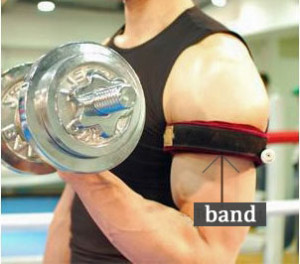How Does Occlusion Training Work in Increasing muscle?
Before I answer this question in detail, I will try and explain exactly what occlusion training is, because not a lot of people would have heard of this before.
Occlusion training, a.k.a. blood flow restriction training (makes it easier to understand) in fitness circles, is a technique where while training with heavy weights the blood flow to the target muscles is restricted. It is the limbs where its done usually. Seems crazy right?
How can restriction in blood flow impact muscle growth at all?
Well, it does help.
So in this article, I am going to tell you how occlusion training works, my personal experience with this training form of training, and who is this training most useful for.
Contents
The working of occlusion training
When you go to the gym and your trainer asks you to take deep breaths in between each set, the primary reason behind it is to provide additional oxygen to your body through improved blood flow, resulting in a surge of energy. Restricting the blood flow is just like going opposite to this approach, isn’t it? It’d suffocate your body for energy, right?
Now here lays the secret: You don’t have to completely restrict the blood flow,[1] but restrict it only in veins of those muscles which are the focus of your exercise.
Occlusion training increases your muscles in three steps:
- If you are a regular visitor to the gym, you would have heard the phrase ‘I am all pumped’ at least a dozen times. Even I use this phrase a lot while showing off my muscles after the workout, even though the ‘pump’ usually dies out by morning. Since the blood is flowing in and not out, your muscle cells would eventually reach a point where they are so packed with fluid that they would have just two options, either to burst out or grow.[2] Guess which one is not ugly?
- Once the muscle cells are packed with fluid, there is a drop in oxygen levels. The body starts deputing more muscle fibers to assist them in the job.[3] The involvement of more muscle fibers during the same old workout results in their growth.
- Lower oxygen levels increase the amount of accumulated lactic acid (a.k.a the burn) in the muscles. This may sound bad, but studies show that lactic acid accumulation is an indicator of protein breakdown and growth.[4] I hope you remember, that amino acids formed after protein breakdown are the building blocks of our muscles.
Beginning to grow bigger with bands
When you start with occlusion training, you use a restriction band or a wrap to apply pressure on the veins of the limb under focus and restrict the blood flow. Pay a little attention here: I said restricting blood flow in the veins, which actually means that the muscles will still receive fresh blood. It will just not flow back to the heart.[5]
My experience with occlusion training
When I started going to the gym and saw some of the big guys training with weights while wearing bands on their biceps, I assumed
they meant for support. I was working with light weights and it seemed awkward that I should use bands for support. I never even bothered to clarify on the purpose they served. Mainly because I was afraid. I could clearly see that people using those bands were lifting almost thrice the weight I was.
Six months in, I moved on to heavier weights and decided to use one of those bands. For support.
Just after a couple of exercises, I found my biceps twice as pumped as they usually get. In addition, I was unable to complete my sets. I couldn’t even complete half of my scheduled reps. Plus, my muscles were awfully sore. That is when I decided to ask about their real purpose. That was the last day when I tried my hands on occlusion training. I was never in for heavy muscle building, and that was exactly what occlusion is meant for.
So next time you say ‘I am all pumped’, try your exercises with one of those bands on and you’ll realize what getting pumped means.
Some words of caution
Workout is all about being cautious and you have to do everything right in order to extract the maximum advantage. Here are a few things that you should keep in mind.
- Occlusion is not for beginners. This method of training should start when you already have strong muscles. This actually means that you should not try it until you have been going to the gym for at least 6 months.
- It will make your muscles sore and by the end of the exercise even the lighter weights would feel very heavy.
- Occlusion is not at all beneficial for people who are in for just fitness or medium muscle building as this training methodology is going to result in rapid muscle build up provided your technique and diet are right.
- You have to make sure that the band is used properly. Wrapping it very tight is going to restrict flow in your arteries which should not happen. Studies say that on a scale of 10 if you say that the grip of the band is 6-7, you should be fine.[6] Any tight would mean your arteries would get collapsed, and any loose would mean no benefit at all.
- You should restrict your breaks between every set to less than 30 seconds.
If you are really serious about muscle building and have been going to the gym for some time, try out this technique and share below what change you observed.
Related Articles
- Can Eccentric Training Increase Muscle and Strength?
- 5 Ways To Build a Bigger Chest Like Hercules
- Which Is The Best Rep Range For Muscle Building?
References [1] Kacin, A., & Strazar, K. (2011). Frequent low-load ischemic resistance exercise to failure enhances muscle oxygen delivery and endurance capacity. Scandinavian Journal of Medicine & Science in Sports, 21 (6) DOI: 10.1111/j.1600-0838.2010.01260.x ^Back to Top^ [2] Nielsen, O. (2006). Lactic acid accumulation is an advantage/disadvantage during muscle activity. Journal of Applied Physiology, 101 (1), 367-368 DOI: 10.1152/japplphysiol.00181.2006 ^Back to Top^ [3] Loenneke, J., Fahs, C., Rossow, L., Abe, T., & Bemben, M. (2012). The anabolic benefits of venous blood flow restriction training may be induced by muscle cell swelling. Medical Hypotheses, 78 (1), 151-154 DOI: 10.1016/j.mehy.2011.10.014 ^Back to Top^ [4] Loenneke, J., Fahs, C., Wilson, J., & Bemben, M. (2011). Blood flow restriction: The metabolite/volume threshold theory. Medical Hypotheses, 77 (5), 748-752 DOI: 10.1016/j.mehy.2011.07.029 ^Back to Top^ [5] Loenneke, J., Abe, T., Wilson, J., Ugrinowitsch, C., & Bemben, M. (2012). Blood Flow Restriction: How Does It Work? Frontiers in Physiology, 3 DOI: 10.3389/fphys.2012.00392 ^Back to Top^ [6] Loenneke, J., Wilson, J., Marín, P., Zourdos, M., & Bemben, M. (2011). Low intensity blood flow restriction training: a meta-analysis. European Journal of Applied Physiology, 112 (5), 1849-1859 DOI: 10.1007/s00421-011-2167-x ^Back to Top^
Last Updated: May 26, 2014
Next Scheduled Update: Jul 26, 2014






Comments are off this post!